Effect of nitrogen source (biodigester effluent, raw manure, and urea) on biomass yield of Guinea grass (Panicum maximum), and effect of different heights of cutting on parasite infection in growing goats
Nguyen Ky Son, Dinh Van Binh , Nguyen Thi Mui and Ngo Tien Dung
Goat and Rabbit Research Center,
Bavi, North Vietnam
nguyenkyson03@yahoo.com;
binhbavi@netnam.vn
Abstract
Two experiments were carried out to study the effects of different
nitrogen sources (biodigester effluent, raw manure, and urea) on
biomass yield of Guinea grass and effect of different cutting
heights on the intestinal nematode infestation in young growing goats
In experiment 2, 24 goats with initial body weight of 13 to 15 kg were allocated to 6 treatments corresponding to the 6 sources of guinea grass harvested from the plots in experiment 1. The design was a 3*2 factorial arrangement with 4 replications, the two factors being: type of fertilizer (BE, RM or U) and height of cutting (L or H). Initial live weight of the goat was used as a covariate to adjust live weight gain during the experimental period. The goats were kept in individual cages. The diets consisted of guinea grass and concentrate. The fresh grass from the six sources was offered ad libitum with an offer level approximately 25% above the recorded intake. The concentrate was fed at 200 g/day and consisted of 40% dried cassava root, 30% rice bran, 28% soya bean meal and 2% minerals). The length of the experiment was 90 days. The goats were de-wormed with Invemactin before starting on the experiment. They were weighed at the beginning and at ten days intervals. Representative samples of feeds offered and refused were taken during the experiment and analysed for DM, CP and Ash. Faecal samples were taken directly from the rectum at the beginning of the experiment and every 30 days of the experimental period.
Biomass yield of guinea grass was higher when it was fertilized with biodigester effluent compared with raw manure or urea, at similar levels of N (120 kg N/ha). There were no differences in content of crude protein among the treatments. Goats fed guinea grass cut at 10 to 12 cm above soil level grew faster than goats fed the grass cut close to the soil (3 to 5 cm above the soil). Counts of coccidia oocysts in faeces were lower for goats fed grass cut at the high level compared with the low level and the same pattern was observed for nematode eggs in faces when the grass was fertilized with biodigester effluent or raw manure. This difference in nematode FEC was not apparent when the grass was fertilized with urea. On average, both coccidia oocysts in faeces and nematode FEC, were lower when the grass was fertilized with biodigester effluent or urea, compared with raw manure.
Key words: biodigester effluent, goats, growth, guinea grass, parasites, raw manure, urea,
Introduction
A principal characteristic of the goat is its dietary selectivity, which enables it to survive in apparently harsh environments. Some researchers have pointed out that the goat is more susceptible to parasites than sheep and that their resistance to the humid tropical climate is not as good as is the case for cattle or sheep (Baxendell 1984; Dunn 1978; Restrepo and Preston 1989). In India, parasites were considered to be a major health hazard for goats particularly in hilly and swampy regions (Battacharya 1989). In Kenya, endoparasites were also considered to be a major constraint to goat improvement (Shavulimo 1989). Thus a first priority in any production program for goats in the humid tropic is parasite control. In this respect, avoidance of re-infestation is more cost effective and biologically sustainable than use of anthelmintics. The features of this strategy are: complete confinement; uncontaminated forages, dry bedding and use of locally available feed resources according to the principles of balanced nutrients both for the rumen and for the animal (Restrepo and Preston 1989).
The practice of the farmers, especially in hilly land with shallow soils, is to plant and harvest crops but with little investment in fertilizers. The fertilizer used for planting grass is very low, for economic reasons: low price for grass and high cost of fertilizer. Normally, the farmers use some of kind of traditional fertilizer such as live stock manure, green manure or ash.
It is very important to find out a cheaper way of supplying plant nutrients such as integrating livestock into the system, with utilization of the manure in biodigesters and application of the effluent as fertilizer for crop production (Rodriguez and Preston 1996; Moog al 1997). In recent years, biodigesters have become popular in Vietnam with the advantage of improving the environment; the health of humans and animals by elimination of pathogens and no loss of nutrients for plant growth. Also they supply energy for cooking ( Bui Xuan An al 1997). Since 1994, the Goat and Rabbit Research center has been transferring technologies to farmers by setting up biodigester systems. The effluent resource from biodigesters is an abundant and cheap fertilizer easily applied by farmers, and which can be used to replace the inorganic fertilizers. In the Goat and Rabbit Research Center there is much interest in means of reducing parasite infestation of the animals. The use of biodigesters and earthworms to process raw manure was estimated to reduce by about eighty percent the parasite infestation rate in the animals (Dinh Van Binh and Nguyen Duy Ly 2002).
The aims of this study were to determine:
-
the biomass yield of guinea grass fertilized with three sources of nitrogen (biodigester effluent, raw manure, and urea)
-
the degree of parasite infestation in goats fed the guinea grass cut at different heights above ground level..
Materials and methods
Experiment 1:
Treatments and design
The treatments in a split-plot 3*2 factorial arrangement were three sources of nitrogen (main plots) and two cutting heights: The N sources were:
-
BE (biodigester effluent)
-
RM (raw manure)
-
U (urea)
The two cutting heights were:
-
L (low level: 3-5 cm above soil level)
-
H (high level: 10-12 cm)
The experimental treatments were replicated four times
in a randomized block layout. The experiment
began on February 2004 and continued until January 2005
There were 12 main plots and 24 sub-plots of Guinea grass. The area of each main plot was 10*20 m and of the sub-plots 10*10m. Total area was: 3000m². All the nitrogen sources were applied in equal amounts every month at overall level of 120 kg N/ha/year. Raw manure from goats and rabbits and biodigester effluent were analyzed for nitrogen (Table 1). Urea and raw manure were diluted with water to have the same solids (DM) content as the biodigester effluent before application to the grass. The first harvest was made at 2 months after planting (beginning February 2004) then at intervals for the regrowth (about every 45 days) until January 2005.
Measurements and statistical analysis
In each plot 5 randomized sub-plots (2* 2 m)
were chosen to measure biomass yield, which was calculated as an
average of 5 sub-plots. The sub-plots were chosen without a zone
around them. Measurements were made of yield of DM and
crude protein (CP). The samples from 5 sub-plots were mixed and 1 sample was
taken for analysis
The data were analysed statistically using the GLM procedure
of Minitab Software, version 13.1 (Minitab, 2000). Sources of
variation were: fertilizers, cutting height, interaction fertilizers*cutting height, blocks and error. The treatment means
which showed significant differences in the "F" test, at the probability level of
P<0.05, were compared with each other using Tukey's pairwise
comparison procedures in Minitab Software, version
13.1.
Experiment 2
24 crossbred goats (Jumnapary*Bachthao) with initial body weight of 13 to 15 kg were allocated to 6 treatments corresponding to the 6 sources of guinea grass harvested from the plots in experiment 1. The design was a 3*2 factorial arrangement with 4 replications, the two factors being: type of fertilizer (BE, RM or U) and height of cutting (L or H). They were confined in pairs in wooden pens of 1.2 x 1.4m area on a raised slatted floor, which was cleaned daily. The goats were fed the experimental diet for a preliminary period of 10 days and de-wormed (Ivermectin at 1.5 ml/10 kg live weight) before starting the experiment. The experiment began on 16 June and continued until 15 September 2004. The diets consisted of guinea grass and concentrate. The fresh grass from the six sources was offered ad libitum with an offer level approximately 25% above the recorded intake. The concentrate was fed at 200 g/day and consisted of 40% dried cassava root, 30% rice bran, 28% soya bean meal and 2% minerals). They were weighed at the beginning and at ten days intervals. Initial live weight of the goat was used as a covariate to adjust live weight gain during the experimental period. Representative samples of feeds offered and refused were taken during the experiment and analysed for DM, CP and Ash (AOAC 1990). Faecal samples were taken directly from the rectum at the beginning of the experiment and every 30 days of the experimental period.
Measurements and statistical analysis
Feeds offered and refused were recorded daily. Live weights were taken at 15-day intervals. Faecal samples were taken directly from the rectum at the beginning of the experiment and every 30 days of the experimental period. Those samples were put immediately in plastic bags to prevent access of moist air, which may lead to the hatching of the eggs of the parasites. They were stored in a refrigerator at 4 ºC until the parasite eggs were counted. The faecal samples (4 g) were ground and mixed with 56 ml of flotation fluid (either saturated sugar or salt solution diluted with water). After filtering through a "tea strainer", a sub-sample was transferred to both cells of a McMaster counting chamber and allowed to stand for 5 minutes. All nematode eggs and coccidian oocysts were counted under a microscope at 10x10 magnification and multiplied by 50 to yield the EPG (Eggs per gramme) of faeces (Hansen and Perry 1994).
The growth and feed intake data and faecal egg counts were
analysed by the One-way option of the ANOVA software from Minitab
(version 12.1). Variables were treatments and error
Results and discussion
Experiment 1
The N content of the biodigester effluent was less than half that reported by San Thy et al (2003) and San Thy and Pheng Buntha (2005) where the values were from 890 to 1690 and 1040 mg/liter, respectively (Table 1). The differences were probably because in the latter experiments, the manure used to charge the biodigester was from pigs and the design of the biodigester was a "plug-flow" plastic tube. In the present experiment the biodigester was the "Chinese model" and was charged with the urine and small particles from the manure (from goats and rabbits), after passing it through a wire mesh with 0.5 cm spacing.
|
Table 1. The composition of biodigester effluent and raw manure |
||||
|
|
N |
P |
K |
DM |
|
Biodigester effluent, mg/liter |
375 |
31.8 |
61.6 |
|
|
Raw manure, g/kg |
1.34 |
1.99 |
0.68 |
26.5 |
The biomass DM yields were higher and there was more crude protein in the DM when biodigester effluent was used compared with raw manure or urea. Similar findings were reported by Le Ha Chau (1998) when raw manure or biodigester effluent was applied to cassava and duckweed. There were no differences in these parameters due to height of cutting.
|
Table 2. The biomass yield and crude protein content of guineas grass fertilized with biodigester effluent (BE), raw manure (RM) or urea (U) and two heights of cutting |
|||||
|
Fertilizer source |
Cutting height |
||||
|
BE |
RM |
U |
HC |
LC |
|
| DM, tonnes/ha |
46.8a |
43.5b |
43.7b |
44.5 |
44.7 |
| CP, % in DM |
10.5a |
10.3b |
10.25b |
10.3 |
10.4 |
| ab Means within main effects without common letter are different at p<0.05 | |||||
 |
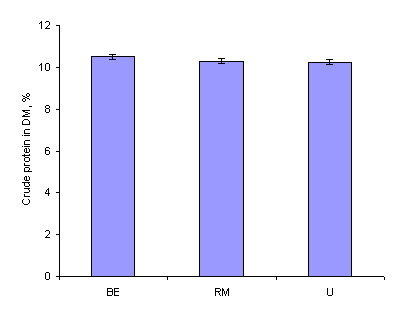 |
| Figure 1: DM yield of guineas grass fertilized with biodigester effluent (BE), raw manure (RM) or urea (U) | Figure 2. The crude protein content of guineas grass fertilized with biodigester effluent (BE), raw manure (RM) or urea (U). |
Experiment 2:
Feed intake and growth
There were no differences in intake or growth rate due to the source of the fertilizer, therefore only data for cutting height are presented (Table 3). There were no differences in total intakes of DM due to the cutting height of the grass; however, final live weights and daily live weight gains were higher when goats were fed grass cut at the high level compared with the low level.
|
Table 3. Mean values for changes in live weight and feed intake of goats fed guinea grass cut at high (GH) or low (LH) heights |
||
|
|
LH |
GH |
|
Live weight, kg |
|
|
|
Initial |
10.4 ± 0.31 |
10.5 ± 0.43 |
|
Final |
15.6b ± 0.45 |
17.5a ± 0.37 |
|
Daily gain, g/day |
43.3b |
58.3a |
|
Feed intake (fresh basis), g/day |
||
|
Forage |
1156a ± 11 |
1198b ± 12 |
|
Concentrate |
160 ± 0.6 |
161 ± 0.7 |
|
Feed intake, g DM/day |
||
|
Forage |
219 ± 2 |
212 ± 2.2 |
|
Concentrate |
142 ± 0.5 |
143 ± 0.6 |
|
Total |
362 ± 2.4 |
355 ± 2.4 |
|
ab Means in the same row without common letter are different at p<0.05 |
||
Nematode infestation
On all the treatments the FEC increased during the experiment (Figures 3 to 5). Goats fed guinea grass fertilized with biodigester effluent had lower FEC from 60 to 120 days, when the grass was cut high rather than low (Figure 3); however, there appeared to be no differences due to cutting height for grass fertilized with raw manure, except at the last sampling date when the FEC were lower for the high cutting (Figure 4). On the urea treatment (Figure 5), there were no differences on any of the sampling days as between low and high cutting. Counts of nematode worm eggs in the faeces were lower when the grass was fertilized with biodigester effluent or urea compared with raw manure (Figure 6).
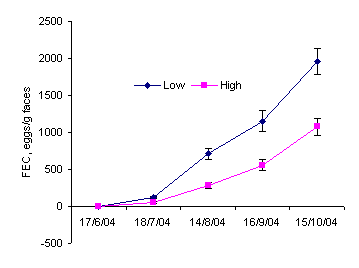 |
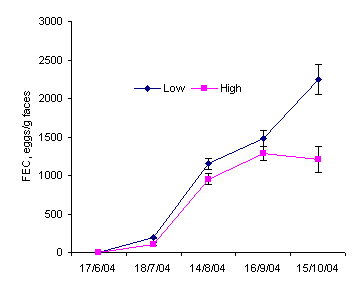 |
| Figure 3. Trends in FEC of nematode parasites in goats fed guinea grass fertilized with biodigester effluent and cut at low height (3 to 5 cm) or high (10 to 12 cm) | Figure 4. Trends in FEC of nematode parasites in goats fed guinea grass fertilized with raw manure and cut at low height (3 to 5 cm) or high (10 to 12 cm) |
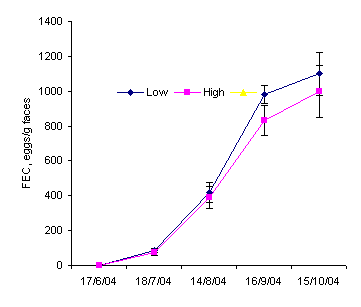 |
 |
| Figure 5. Trends in FEC of nematode parasites in goats fed guinea grass fertilized with urea and cut at low height (3 to 5 cm) or high (10 to 12 cm) | Figure 6. Trends in FEC of nematode parasites in goats fed guinea grass fertilized with biodigester effluent (BE), raw manure (RM) or urea (U) (mean values for both cutting heights) |
On all fertilizer treatments there were lower counts of coccidia oocysts in faeces of goats fed guinea grass cut at high level compared with the low level (Figures 7 to 9). Counts of coccidia oocysts in faeces were lower when the grass was fertilized with biodigester effluent or urea compared with raw manure (Figure 10).
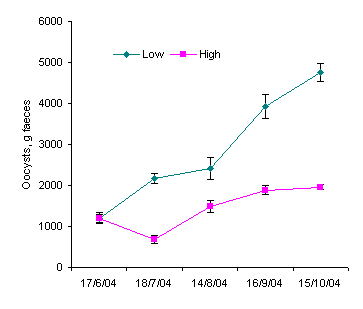 |
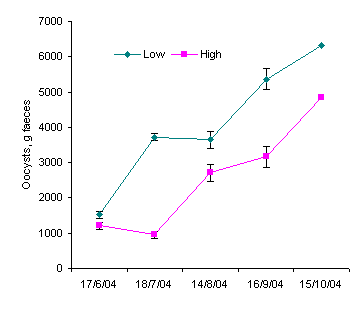 |
| Figure 7. Trends in coccidia oocysts in faeces of goats fed guinea grass fertilized with biodigester effluent and cut at low height (3 to 5 cm) or high (10 to 12 cm) | Figure 8. Trends in coccidia oocysts in faeces of goats fed guinea grass fertilized with raw manure and cut at low height (3 to 5 cm) or high (10 to 12 cm) |
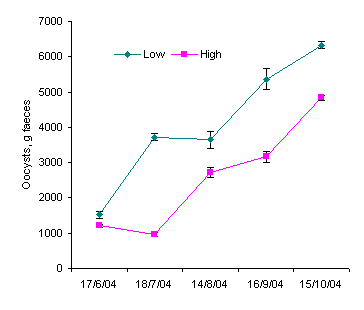 |
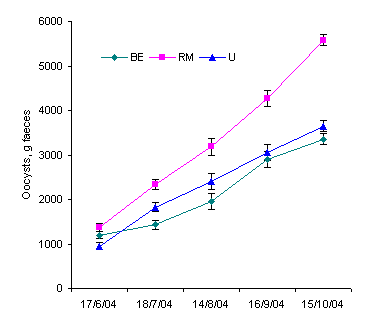 |
| Figure 9. Trends in coccidia oocysts in faeces of goats fed guinea grass fertilized with urea and cut at low height (3 to 5 cm) or high (10 to 12 cm) | Figure 10. Trends in coccidia oocysts in faeces of goats fed guinea grass fertilized with biodigester effluent (BE), raw manure (RM) or urea (U) (mean values for both cutting heights) |
|
Table 4: Mean values (and SEM) for FEC of intestinal nematodes and cocidia oocycts (counts/g of faeces) |
|||||||
|
date |
BE-GL |
BE-GH |
RM-GL |
RM-GH |
U-GL |
U -GH |
|
|
FEC of nematodes, eggs/g faeces |
|
|
|||||
|
17/6/04 |
2.5 ± 1.2 |
2.3 ± 0.9 |
2.8 ± 1 |
2.6 ± 1.5 |
2.5±1.2 |
2.1±1 |
|
|
18/7/04 |
122 b ± 11 |
54 c± 12 |
192 a ± 7 |
110b ± 14 |
86c±13 |
72c±12 |
|
|
14/8/04 |
713b ± 74 |
281c ± 41 |
1150a ± 67 |
950 a ± 72 |
420c±56 |
390c±62 |
|
|
16/9/04 |
1150 a ± 142 |
560 c ± 74 |
1480 a ± 104 |
1287 a ± 86 |
980c±53 |
830c±86 |
|
|
15/10/04 |
1960 b ± 178 |
1080b ± 115 |
2250a ± 194 |
1208 b ± 169 |
1100b±124 |
1000b±150 |
|
|
17/6/04 |
1207 b ± 127 |
1190 b ± 96 |
1527 a ± 102 |
1207 b ± 52 |
1070b±102 |
840c±17 |
|
|
18/7/04 |
2170 b ± 127 |
690 c ± 96 |
3720a ± 102 |
957c ± 52 |
1896b±130 |
1752b±122 |
|
|
14/8/04 |
2413 b ± 269 |
1487 c ± 145 |
3650a ± 244 |
2713 b ± 143 |
2420b±156 |
2390b±142 |
|
|
16/9/04 |
3918 b ± 295 |
1890 c ± 107 |
5370a ± 311 |
3160 b± 152 |
3280b±53 |
2830b±186 |
|
|
15/10/04 |
4755b ± 220 |
1963c ± 68 |
6328a ± 96 |
4835b ± 64 |
4100b±124 |
3200b±150 |
|
|
ab Means in the same row without common letter are different at p<0.05 |
|||||||
The higher growth rates of goats given guinea grass cut 10 to 12 cm above soil level compared with those fed grass cut at a low level is in agreement with the report of Nguyen Kim Lin et al (2003) who used similar cutting treatments on guinea grass fed to growing goats. However, the pattern of faecal nematode egg counts was less consistent with differences in favour of high cutting being significant only in the case of fertilization with biodigester effluent and in samples after 120 days of experiment in the case of the raw manure treatment. The advantages of cutting the grass at a high level are supported by the observations of Coffey et al (2001), who showed that when the grass was tall the infective nematode larvae did not climb to the top of the plant. The higher overall values (means for low and high cutting) on the raw manure, compared with biodigester effluent and urea, would appear to support the belief that the process of biodigestion reduces the viability of parasite eggs present in the original manure.
Conclusions
-
Biomass yield of guinea grass was higher when it was fertilized with biodigester effluent compared with raw manure or urea, at similar levels of N (120 kg N/ha).
-
Goats fed guinea grass cut at 10 to 12 cm above soil level grew faster than goats fed the grass cut close to the soil (3 to 5 cm above the soil).
-
Counts of coccidia oocysts in faeces were lower for goats fed grass cut at the high level compared with the low level and the same pattern was observed for nematode eggs on faces when the grass was fertilized with biodigester effluent or raw manure. This difference in nematode FEC was not apparent when the grass was fertilized with urea.
-
On average, both coccidia oocysts in faeces and nematode FEC, were lower when the grass was fertilized with biodigester effluent or urea, compared with raw manure.
Acknowledgements
We acknowledge
the financial support for this research from the SAREC-MEKARN project, and
the advice and guidance received from Dr
T R. Preston.
References
Bui Xuan An, Preston T R and Dolberg F 1997a The introduction of low-cost polyethylene tube biodigesters on small scale farms in Vietnam, Livestock Research for Rural Development, 9:2 http://www.cipav.org.co/lrrd/lrrd9/2/an92.htm
Dinh Van Binh and Nguyen Duy Ly2004 National workshop on integrated prevention of parasite diseases on goats, 18th-21st of April 2004 in GRRC (TAG 443/project)
Hansen J and Perry B 1994 The epidemiology diagnosis and control of helminth parasites of ruminants, International Laboratory for Research on Animal Diseases, Nairobi, Kenya. pp.73-92
KeanSophea and Preston T R 2001 Comparison of
biodigester effluent and urea as fertilizer for water spinach
vegetable. Livestock Research for Rural Development (13) 6:
http://www.cipav.org.co/lrrd/lrrd13/6/Kean136.htm
Le Ha Chau 1998 Biodigestereffluent versus
manure from pigs or cattle as fertilizer production of cassava
foliage (Manihot esculenta). Livestock Research for
Rural Development, Volume 10, Number 3 http://www.cipav.org.co/lrrd/lrrd10/3/chau1.htm
Moog F A, Avilla H F, Agpaoa E V, Valenzuela F G and
Concepcion F C 1997 Promotion and utilization of
polyethylene biodigester in smallhold farming systems in the
Philippines. . Livestock Research for Rural Development (11) 2:
http://www.cipav.org.co/lrrd/lrrd11/2/moog92.htm
Nguyen Quang Suc, Le thu Ha and Dinh Van Binh 2000
Manure from rabbits, goats, cattle and buffaloes as substrate
for earthworms. National workshop on sustainable livestock
production on local feed resources, http://www.mekarn.org/sarpro/sucew.htm
Rodriguez Lylian and T.R Preston T R 1996 Useof
effluent from low cost plastic biodigester asfertilizer for
duckweed ponds. Livestock Research for rural
Development. (9) 2: http://www.cipav.org.co/lrrd/lrrd9/2/lylian92.htm